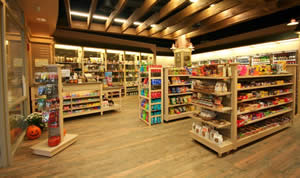Difference between Supermarket and Convenience Store
Key Difference: Supermarkets are large self-service grocery stores that offer customers a variety of foods and household supplies. The merchandise is organized into an organized aisle format, where each aisle is numbered or labeled and has only similar goods placed together. Convenience stores are small stores that are open for long hours and offer a small variety of goods. Convenience stores stock on goods that a person might require in an emergency and would not like travelling long distances for it.
Supermarket and convenience stores are two different kinds of shopping avenues. Supermarkets are large stores that stock up on groceries and household products, while convenience stores only stock up on goods that a person may require in emergency. Supermarkets and convenience stores differ from each other in many ways.
 Supermarkets are large self-service grocery stores that offer customers a variety of foods and household supplies. The merchandise is organized into an organized aisle format, where each aisle is numbered or labeled and has only similar goods placed together. The supermarket houses fresh foods, poultry as well as canned and boxed goods. Supermarkets are quite larger compared to traditional grocery stores, where people are available behind the counter to provide the consumer with goods and the consumer stands in front of the counter asking for the goods. However, supermarkets are smaller than hypermarkets or big-box markets, which are basically supermarkets combined with departmental stores.
Supermarkets are large self-service grocery stores that offer customers a variety of foods and household supplies. The merchandise is organized into an organized aisle format, where each aisle is numbered or labeled and has only similar goods placed together. The supermarket houses fresh foods, poultry as well as canned and boxed goods. Supermarkets are quite larger compared to traditional grocery stores, where people are available behind the counter to provide the consumer with goods and the consumer stands in front of the counter asking for the goods. However, supermarkets are smaller than hypermarkets or big-box markets, which are basically supermarkets combined with departmental stores.
Supermarkets have a special format where it allows consumers to pass through aisles using shopping carts or baskets and pick up whatever they require. Although, the early supermarkets did not house fresh grocery or meat, modern supermarkets have meats, poultry, bread, dairy products and fresh fruits and vegetables. In addition to fresh and canned food, supermarkets also keep household products such as cleaning supplies, baby goods, pet needs, medicine, kitchen appliances, crockery, etc. Supermarkets offer low prices and many deals or discounts on their products to attract consumers. Some even operate on negative profit margins sometimes to bring in customers. Supermarkets usually receive goods and merchandise in bulk from either manufacturers or large distributors in order to avail economies of scale. The profit margin is usually very small and the discounts are forwarded to the customers. Supermarkets may also be part of a huge chain system and may be closer to other supermarkets. Supermarkets closer together can save even more on costs by sharing distributors and slashing their transportation costs. Supermarkets are usually one-level brick and mortar store but may also include two floors depending on the amount of supplies that are kept.
The concept of an inexpensive food market that relies on discounts based on economies of scale was developed by Vincent Astor, who founded the Astor Market in 1915 but failed to be able to make a successful venture and shuttered it in 1917. The first self-service grocery store concept was developed by entrepreneur Clarence Saunders, who founded the Piggly Wiggly stores in 1916. The store become a financial success and become a franchise. Slowly, the concept started becoming popular all over the world, with many developed countries establishing their own self-service grocery stores. In the developing countries, self-service grocery stores are a recent phenomenon and have received only gained popularity in the last decade or so. Specifically in these countries, many supermarkets also offer loose or open merchandise similar to old grocery stores. People can measure our grains, rice and other staple products and buy it by weight. Supermarkets have also started offering ready-to-eat foods as a way to provide the customer to shop as well as eat at the same time. Some supermarkets may also have banks, ATMs, coffee bar, juice bar and anything else that may attract customers.
 Convenience stores are small stores that are open for long hours and offer a small variety of goods. These stores are also known as corner store, corner shop, party store and bodega (in Spanish speaking areas). Convenience stores stock on goods that a person might require in an emergency and would not like travelling long distances for it. These stores are located in busy streets, street corners, highways, etc. They are used by both locals as well as travelers. Convenience stores are commonly connected with a highway, to provide customers with eatables, drinks, bathroom, tobacco, cigarettes, alcohol, etc. It also has limited grocery items such as milk, ice cream, candy, soft-drinks, etc.
Convenience stores are small stores that are open for long hours and offer a small variety of goods. These stores are also known as corner store, corner shop, party store and bodega (in Spanish speaking areas). Convenience stores stock on goods that a person might require in an emergency and would not like travelling long distances for it. These stores are located in busy streets, street corners, highways, etc. They are used by both locals as well as travelers. Convenience stores are commonly connected with a highway, to provide customers with eatables, drinks, bathroom, tobacco, cigarettes, alcohol, etc. It also has limited grocery items such as milk, ice cream, candy, soft-drinks, etc.
The stores are located in places where they are easily available and are open longer hours, with some even being open 24 hours, such as 7-11. Some of these convenience stores can also offer liquor if they have the license. Normally, they only keep beer and wine, with more hard liquors available in proper liquor stores. Convenience stores are also popular for offering lottery tickets, scratch cards, newspapers, magazines, slushies, soft drinks, coffee, tea, sandwhiches, bagels, hot dogs, pizza, etc. They may also offer money order and wire transfer services. Convenience stores are also popular for contraceptives and hygienic products such as toilet rolls, soaps, etc. Stores that are near fishing destinations may also provide live bait.
Many stores follow a similar format to establish the store. The checkout counter is near the front of the store in a corner. There a 2-3 aisles that are loaded with products, with cigarettes, lottery tickets, money order services and magazine racks up front near the checkout counter. The ready food is placed near the back to one side with microwave ovens, coffee machines and slushie machines near the food. The store comes with an attached bathroom for the customers. There will also be a cooler for keep drinks, ice cream and other foods that require cold. The stores that are open 24/7 may also have a bullet-proof glass on the checkout counter to protect their employees from robbers. Convenience stores offer slightly higher prices compared to supermarkets and hypermarkets, and also provide faster service.
Image Courtesy: guardian.co.uk, kazooga.com









Add new comment